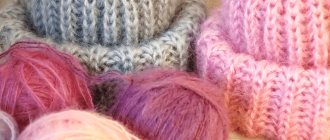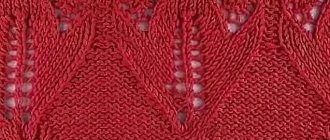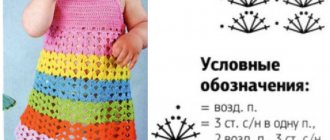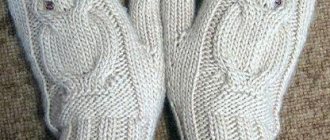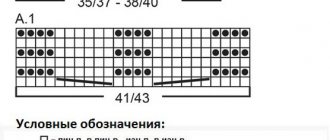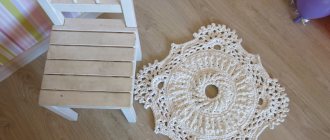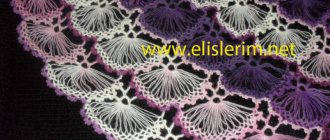Varieties of stoles
This type of women's clothing once came from men's fashion - Norman fishermen wrapped themselves in knitted items in chilly weather during storms. Later they began to be knitted in the Russian outback for women, with openwork patterns and scalloped edges, along with Orenburg down scarves and shawls.
Today, a beautiful stole model has every chance of becoming a worthy decoration for a woman’s wardrobe for any age category. Hollywood divas have repeatedly appeared with similar accessories at important events.
A winter stole is something between a narrow blanket and a large scarf. It is knitted to the full length of the body; if necessary, you can take a little nap on the road, covering yourself with a wide handmade product. The product casually thrown over the shoulders performs the same functions as warm shawls made of angora down, sheep wool or llama.
An openwork summer train made of silk in the form of a thin patterned stole is the best alternative to a cape over bare shoulders under an evening outfit. The wives of monarchs and top officials of states wore them at coronations and ceremonial receptions, where nudity of bodies was not encouraged.
There are also stylish hybrid models that combine the simplicity of a stole and the characteristic features of knitted “transformers”. In such models, slits are left under the armholes and the sleeves are tied. Then the loose flaps fall down the front, like a fashionable cardigan. They are worn loosely under a sheath dress or jeans with a turtleneck.
By turning it over, you can get a shortened version of the garment with long hems and a large shawl collar. They are worn like a vest under a belt.
There are also combined models - with a corner detail on the back. From the back it looks like a shawl or a fashionable poncho, from the front it looks like a regular stole, as in the photo.
Choosing yarn for a stole
The stole is a large format product, so you will need a lot of yarn, at least 4-5 skeins. Suitable for winter models:
- wool and wool mixtures;
- fluffy mohair;
- angora and down yarn.
Note! Craftswomen often use used yarn, unraveling unnecessary sweaters or cardigans. The “chewed” effect is difficult to remove even with damp heat treatment. Such threads can be used for crocheting, where the deformation is not so noticeable.
For non-hot demi-season samples use:
- acrylic;
- mixed threads;
- thin kidmohair;
- textured and shaped yarn (boucle, grass, astrakhan fur).
Summer openwork veils are knitted from thin synthetic threads or from natural-based raw materials:
- viscose;
- cotton;
- bamboo;
- linen;
- silk.
The finished product can be complemented with long tassels, like shawls. Regardless of the yarn, it must be washed and rinsed in warm water, wrung out without stretching, and the process completed in a centrifuge. Dry knitted and washed stoles laid out on terry towels. Store folded or on a trempel (bar “hanger”).
Some basic rules when choosing yarn for knitting a shawl:
- No synthetics! Let's use squeaky acrylics on socks! Nylon does not respond to blocking! This should be especially taken into account if your shawl has a scalloped border or requires complex blocking.
- “Karachaevskaya” and similar cheap threads are also for socks!
- “Mixes” are allowed - mixed compositions. Their main condition is naturalness.
- Sectional-dyed and mélange yarns are suitable for geometric patterns or patterns that repeat monotonously. Otherwise, the sectional may “clog” the pattern, i.e. he will be lost against the background of ripples of colors. But it is ideal for shawls with a pattern arranged in horizontal stripes, such as Kauni yarn - it has very long sections with smooth transitions of shades and colors from section to section.
When you come to the store or decide to order yarn in an online store, you can get confused, because... Now there is a huge selection of yarn from both Russian and foreign manufacturers. How to choose yarn for knitting a shawl? First you need to decide on the shawl model and select
How to knit a stole
The choice of model depends on the skill of using a particular instrument and the experience of the mastritsa. Available version:
- on the fork is a special U-shaped device for knitting openwork paths and shells from beautiful yarn;
- knitting needles (the thicker the yarn, the larger the number, and the faster the product is knitted);
- crochet (different techniques and patterns available).
Let's look at how to connect the simplest models using different tools.
Knitting with knitting needles
Each needlewoman has many interesting and simple patterns in her arsenal, but not all are suitable for scarves and stoles. It is best to choose double-sided patterns, for example, a “peacock feather” face, with a “sheaf” on the back. The final result depends not only on the successful choice of the scheme, but also on the quality of execution.
The selected pattern should be tested in the form of a small sample of about 20 loops or a 10x10 cm square to make preliminary calculations:
- select the knitting density (when it is too tight, increase the size of the knitting needles);
- calculate the number of repeats or how to complement the pattern along the width of the product (the stole is knitted within 45-60 cm);
- evaluate the appearance of the pattern after wet-heat treatment (voluminous weaves often lose volume or look different than in the photo and before washing).
As you know, there are dense winter patterns for winter products and light openwork for summer ones. The simple shape of the stole is also good because you can try a new pattern without worrying about the pattern.
You can start the product with a small bar on which lush tassels or fringe will be attached. The description of the pattern should be clear and easy to remember after several repetitions.
Stole on a fork
Once upon a time this rather simple technique was very popular; it was proposed in Italy for stoles. Today, the fashion for exclusive handmade goods is reviving this type of needlework.
Note! There is only one difficulty for beginners - crocheting long loops exactly in the middle of a U-shaped fork. Having learned how to carefully make long paths, you can begin to manufacture the product.
The most suitable yarn is kidmozher; the product will be light and almost weightless. Assembling a stole is connecting long tracks together. A good way to master the fork knitting technique is to learn from craftswomen who post their master classes on video.
Grass stole
A chic stole knitted from “grass” (a type of fuzzy yarn that imitates fur) is better and easier to knit with knitting needles. In addition to the mesh sections, they require a hook. The model is sized for size 50 with a height of 160cm.
To work you will need:
- “grass” yarn - 4 skeins;
- the yarn is thin, needed for knitting double with “grass” so that the fabric does not stretch;
- wool or p/w yarn for mesh – 100g (100g/350m);
- straight knitting needles No. 4;
- hook No. 2.5.
Scheme of work and master class
We collect the required number of loops from the “grass” - decide how wide the cape you want to get. In the photo, the beginning of mating is indicated in red. We knit it lengthwise with a continuous cloth of grass. For beginner knitters, this model is very convenient - all the stitches are knitted. Then, at regular intervals, we close sections of the loops for the mesh. In the photo it is blue. We continue to knit the remaining loops from grass, knitting strips of the required length. Then we switch to whole knitting, adding the required number of loops on the passes. We close the loops. We will crochet the mesh sections - the direction of the green arrows in the photo. The mesh pattern is VP arches or any openwork. Pom-poms can be made as desired - knitted, woven.
Crochet stole
The most common method of making stoles is crocheting a single piece of fabric. But openwork models made from square motifs sewn together look no worse. As in the description of tips for working with knitting needles, it is important to choose a tool according to the thickness of the yarn:
- for thick threads hooks No. 3 or 4;
- fine yarn - No. 1.5 or 2.
Note! The same pattern is perceived differently in different colors. Not all patterns of mesh products look beautiful in dark yarn, but white yarn will elevate any “simple” pattern.
It is worth taking the time to knit a sample of approximately 10x10 cm in order to accurately calculate the number of elements:
- columns;
- half-columns;
- air loops.
For novice admirers of handmade work, reading the diagram causes some difficulties; the next step is not always clear. In practice, everything is simple - usually the initial row is drawn from a chain of air loops of the required length. Then a pattern is knitted, repeated after several rows.
The simplest patterns are for 2, 4 or 6 repeat rows. When knitting step by step, you can see how the work is progressing along the row and then the diagram becomes easier to read.
Helpful advice! If the selected pattern does not look like in the product, as in the photo in the magazine or in the description on the website, try similar patterns. If you are not satisfied with the product from the very beginning, it has no chance of being completed. It’s better to unravel it, knit it differently and wear it for fun with an interesting pattern.
When you have to knit several openwork squares into a stole, you can experiment with yarn of different colors. This is a great way to repurpose leftover yarn. It is recommended to work with similar shades in the cold or warm range of the spectrum. Traditional contrasting combinations look beautiful. For example, beige and brown, pink and dark gray, blue and emerald.
If you take into account all the recommendations for knitting a stole, the product will turn out fashionable, stylish and effective. Avoid patterns that were popular in the times of our parents, outdated ideas from old magazines. If you have creative inclinations, you can come up with your own pattern, decide to master complex patterns, or realize your own interpretation of this type of knitted clothing.
In conclusion, we offer a selection of schemes for beginners.
Luxurious stole knitted
Knitting a stole means not only having great talent. It's also about patience. Since the product should be voluminous. Normally, the size of an average stole ranges from 1.5 to 2 meters in length. But the width can also reach up to 2 meters . Patterns are not always easy to make.
Some models require constant counting and transferring of loops so that the pattern does not stand across the canvas and does not become askew.
For beginners, choose simple patterns for knitting. Everyone will be able to find both warm winter models and thin lightweight products. You can decorate with a border or yarn called “grass”.
Stoles can be quickly knitted in a variety of patterns: cobwebs, zigzag, streams, with autumn leaves, etc. They are much more practical than down shawls, snoods and just scarves; they can be used as a luxurious, cozy cape.
Advice! Fashion designers offer a knitted stole as a transformer to wear instead of a cardigan under a stylish belt.
Below are the most beautiful models of stoles that craftsmen made with their own hands. For each product there is a detailed step-by-step guide and an abundance of diagrams.
Yellow stole with curls and leaves
Original and bright model. It combines not two patterns, but even three. These are braids or flagella (coils) that are located along the edges (photo) . The leaves occupy a central position between the braids. We knit beautiful diamonds, it is very difficult not to highlight them in the resulting pattern. As a result, one scheme has three fashionable patterns at once. They have merged together so much that it is difficult to imagine the pattern without any of the elements.
For work use:
- yarn with the addition of natural wool;
- knitting needles according to the thickness of the wool thread;
- additional knitting needles for making braids.
Measurements
Measure two indicators for a stole: its width and length. It should not drag on the floor, and it should not be so short that it falls easily if moved awkwardly. Therefore, think about the required dimensions in advance. But it is better to make the length at least 1 meter.
Sample
In order to make a stole exactly to size, you must first knit a special sample. It is made from yarn for a stole, and performed only according to the pattern proposed for it. You don’t need to knit a huge pattern; it’s enough to make it from 30 stitches of the set.
Then, using a measuring device, place it exactly vertically and measure how many loops there will be. Then measure exactly horizontally and how many loops there will be. These two numbers will make up the knitting density. They will help you choose the right size not only for the initial set of loops, but also for the entire length of the product.
Description
Make a set of loops for the stole. This model has dimensions of 60 by 140 cm. Knit directly from the provided pattern. Initially, take into account the number of repeats in the set, and make the number of loops a multiple of the repeat and plus an additional two edge loops. Knit the edge loops according to all the rules so that the edge is even.
the first stitch for each row, and purl the last stitch (regardless of the pattern). Knit the required number of rows. Make sure that there is an even and beautiful ending to the rapport. Finish knitting with the usual closure of the loops; you can use the elastic edge when closing the loops.
This is how a stole is created. You can’t do it in one evening, but several evenings will help you complete what you started. You can decorate it to your taste. For those who like tassels , you can use short tassels for short sides or make the edge completely with fluffy fringe.
Stole with 3D pattern
An original and modern idea is to make a 3D pattern on canvas using knitting needles. Unusual geometric patterns with knitting needles and 3D have become very fashionable - this is one of such patterns. The lush fringe made of contrasting thread adds zest to this product and completeness. The result is a very distinct and fashionable product. Let's look at the detailed master class.
For work use:
- pekhorka yarn of different colors;
- knitting needles according to the thickness of the yarn.
Measurements
Measure the dimensions of the required product. For length, use from a meter, and for width, you can use 60 cm or more.
Sample
In order to correctly calculate the number of loops, you will need to knit a simple square using the stockinette stitch of one of the threads, and calculate the knitting density to it. These are two numbers. The first number will be the number of loops in a row per 10 cm, and the second number is the number of rows for the fabric. Next, calculate how many loops will be needed to cast on, and how many rows will need to be used to complete the product.
Pattern for a stole with a zigzag pattern
Description
Make a set of loops, and be sure to respect the number of loops for repeat. This set should be a multiple of the rapport. Knit according to the jacquard pattern to the required height, and then simply bind off the loops.
Decoration
A very lush fringe along the entire edge of the product can serve as decoration. It must be done with contrasting threads . But you don't need to make the threads too long. A hook will help to connect the fringe and the fabric. Simply bend the threads in half and first thread the resulting loop through the fabric. Then pull all the resulting threads through the loop. Tighten it tighter and one fringe is ready. Do this with each bunch.
Important! To make the fringe even, you need to cut an equal number of threads.
Here is the finished model of a fashionable stole with your own hands. To ensure that the jacquard threads do not interfere, you can simply knit two fabrics using this pattern and sew them on the sides.
